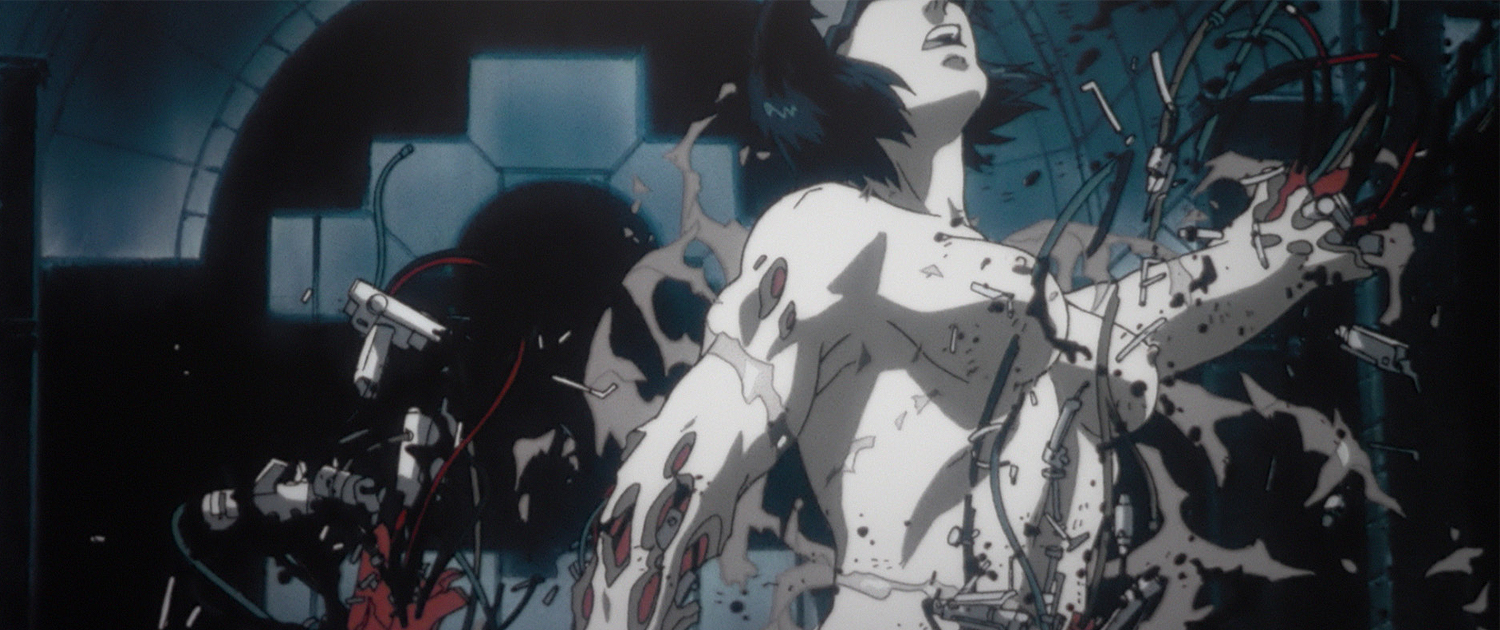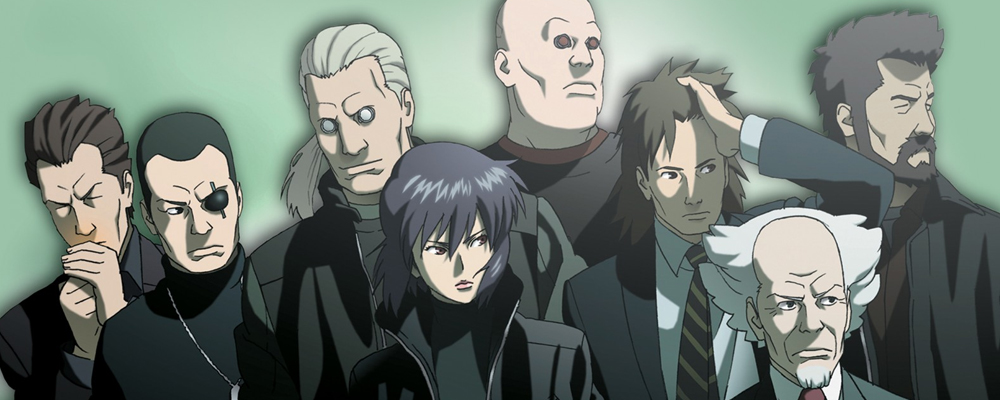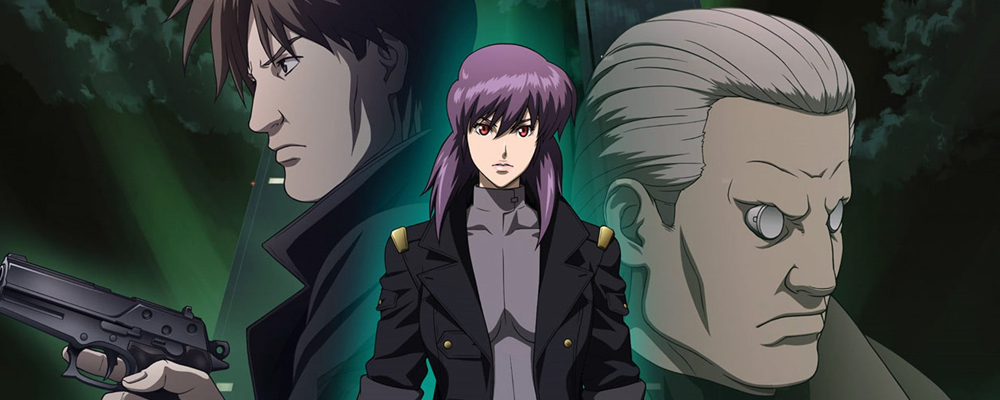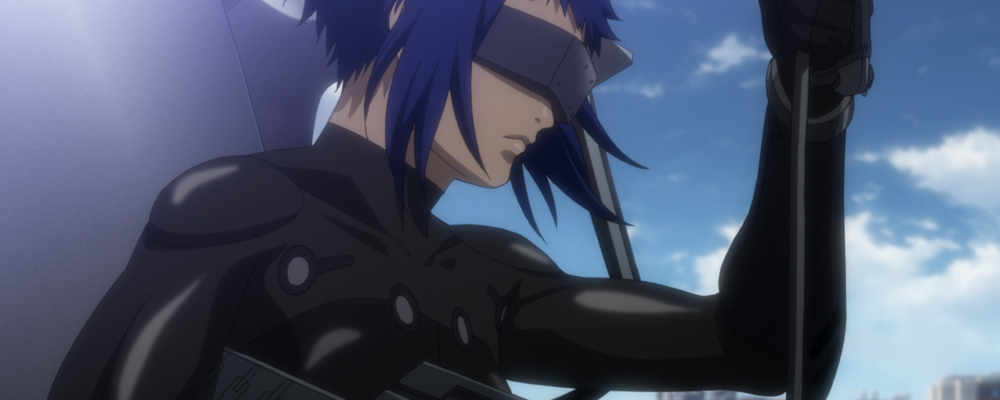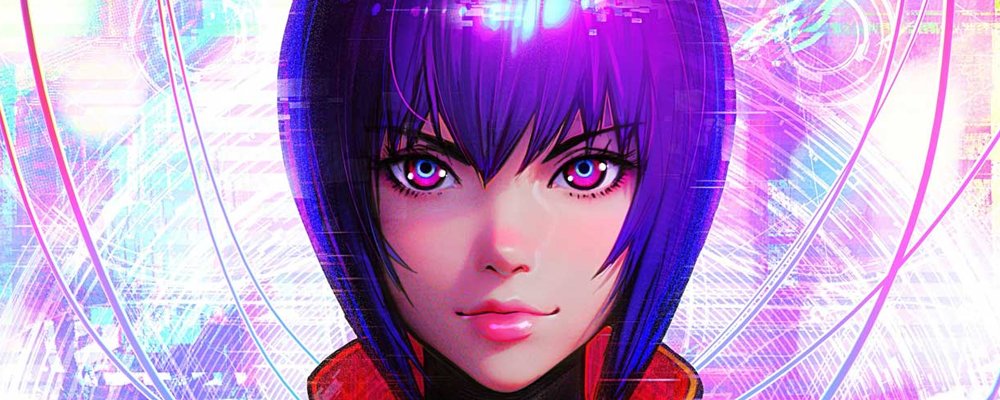Ranking the Ghost in the Shell movies and TV shows from worst to best (UPDATED)
Just feed this directly into my veins…
It’s been a long ride since 1995 – Shirow Masamune’s brilliant 1989 manga aside, the Ghost in the Shell franchise has so far blessed us with a boatload of amazing television series, 4 epic anime movies and one absolutely terrible live action Hollywood adaption.
For the uninitiated it’s difficult to describe exactly what Ghost in the Shell viewers can expect when they first sit down to watch it, but seeing as I wouldn’t be doing my job as an writer if I said nothing, I thought it might be prudent to take a look through the GITS back-catalog and give readers a brief overview of each movie and TV series. This way should anyone feel like getting their feet wet and jumping into the franchise they can use this article as a guide to help them navigate the long list of releases and find a series or film that suits them best.
At its core Ghost in the Shell is essentially a cop show, a very elaborate cop show with incredibly complex (and sometimes downright confusing) plotlines, but a good old fashioned police drama all the same. It’s no “The Bill” or NYPD Blue, sure, in fact many times it blurs the lines between surrealist science fiction, downright existentialism and sometimes even nihilism. The name itself is derived from the main character’s internal struggle to understand where her humanity begins and her manufactured cyborg body ends; the term Ghost referring to Shirow’s vision of how we project our individuality as human beings.
While this may sound ambitious for the premise of a science fiction detective drama, these questions of existential understanding usually present themselves in conundrums that the members of Public Security Section 9 need to face when attempting to tackle the various villains in Japan’s futuristic Newport City.
If you’ve stumbled across this article and you’re new to it all and looking to dive in head first, I’ve compiled a suggested viewing schedule that I think will help new viewers make the most out of their Ghost in the Shell experience:
Ghost in the Shell [Movie - 1995]
Ghost in the Shell 2: Innocence [Movie - 2004]
Stand Alone Complex [TV Series 2002 – 2004]
Solid State Society [TV Movie - 2006]
Ghost in the Shell: SAC_2045 [TV Series 2020 - 2022]
Arise [TV Series - 2013]
Ghost in the Shell: The New Movie [Movie - 2015]
Alternative Architecture [TV Series - 2014]
Ghost in the Shell [Live action movie - 2017]
So without further ado, here are the Ghost in the Shell TV and movies ranked from worst to best:
10. Ghost in the Shell (Live action) [2017]
There’s always an air of, “No thanks we’ve already got one” when Hollywood announces a live action western remake of an anime classic; one more than one occasion I’ve given myself a mini aneurysm stressing over the news of repeated attempts to make westernized versions of Katsuhiro Otomo’s Akira.
While it shares its name with the classic Japanese franchise, it’s best to approach this movie by not thinking about it as a remake at all; blending in elements of the Stand Alone Complex storyline with key visuals from Mamoru Oshii’s original 1995 movie, it actually stands as more of a hybridization than a modern day remake or reboot. A new storyline that replaces the Japanese main character Motoko Kusanagi with a western version of The Major was hacked and slashed into the narrative in an attempt to justify Scarlett Johansson’s existence in the movie. Honestly I think Johansson actually does a great job as a western Kusanagi, but the film itself seems to exist solely to cash in on Johansson’s success in the MCU. Take the Ghost in the Shell title away from this movie and you’re left with a science fiction film that can moderately hold its own, but that’s really as far as it goes.
9. Alternative Architecture [2014]
Intended as a 10 episode extended version of the GITS: Arise OVA series, Alternative Architecture was potentially the most confusing of all the Ghost in the Shell movies and series. AA is the franchise’s attempt to show in detail how Major Kusanagi formed her team and joined Section 9, all while trying to uncover the genesis of a deadly new virus that can infiltrate people’s brains and implant false memories. Set up as both a prequel and a reboot of the GITS franchise, Alternative Architecture takes the seemingly linear story line of Arise and jumbles it around confusingly. Like a scene reminiscent of South Park’s Family Guy joke generator, the chronological order of the series is thrown out the window with Kusanagi’s team seemingly forming AFTER they’re shown working together in episodes 1 and 2. While this was likely done to create a better way of “Setting the scene” for the story that was about to unfold, for a viewer that hadn’t yet watched Arise it would have been unbelievably confusing.
If you’re someone that has never seen a single minute of anything Ghost in the Shell related, more than likely my description above probably seems a little confusing. Just keep in mind however that AA as a whole was just as confusing for GITS veterans as it was for you reading this, which goes a long way in understanding the lukewarm reaction its received since it was launched in 2014.
In all it’s not bad; there are some great visuals and seeing how Section 9’s best team was formed gave me a little bit of a kick and the early interactions between Major Kusanagi and Batou were somewhat amusing. If you’re looking to jump into GITS, this is definitely not the place to do it.
8. Stand Alone Complex (Season 1) [2002]
Ghost in the Shell’s first television series is remembered very fondly within the anime community. Aside from the various reprints of Shirow’s original manga it was the first time since 1995 that Major Kusanagi and Section 9 had made an appearance on anyone’s screens. For the GITS purists it also had the added bonus of drawing its inspiration more from the manga than the theatrical feature, so the audience really got to see the day-to-days of Section 9 instead of just focusing on a single story line or villain.
Honestly, the first time I saw SAC I was ultimately impressed; the series has this weird ability to tickle a certain desire within the audience. When you’re exhausted watching anime about magic-girls, maid cafes and people getting sucked into video games, every now and then it’s great to just engage adult-mode and stimulate some brain cells watching agents solve crimes.
In the first season of SAC, Section 9 are on the hunt for a cyber-terrorist called ‘The Laughing Man’, an individual accused of murder, corporate terrorism and espionage. While attempting to uncover his or her identity, Kusanagi’s team are exposed to secrets that people in positions of power want to see buried and they find themselves under attack from all sides. It’s pretty great.
So with all my gushing over SAC why is it sitting so far down the list? Well, while SAC was pretty revolutionary in expanding upon the Ghost in the Shell universe over the original 1995 movie, the first season was actually pretty confusing at times. Important information would be glossed over very quickly and if you missed something that happened briefly in an earlier episode, suddenly you’re lost wandering down a path that you didn’t know you had even stumbled into. It might take two or even three viewings of season 1 to really come to grips with the mystery of The Laughing Man.
Secondly, SAC turned the character of Major Kusanagi into somewhat or a sexpot. Entire sections of the show seemed to be written exclusively to show her wearing revealing clothing or ridiculous sexy outfits. Seriously, take note of her outfits in season 1, she looks like she dressed herself in the dark or was styled by Stevie Wonder. Her overt sexuality was a stark contrast to the original movie and while giving her agency is something to be applauded, agency was definitely not in the minds of the writers. Showing off them titties to appeal to a younger audience definitely was however.
In all season 1 is a great whodunit. It’s light on action compared to other series or movies, but it’s clearly geared towards the detective qualities of Section 9’s work. For a new viewer it’s not a bad place to dive in and get your feet wet, however be prepared to be confused. Information and dialogue comes shooting at you like Sonic the Hedgehog pinging off a gram of speed, so be prepared to dig in and maybe pull out a notepad for notations.
Oh, and prepare to fall in love with Tachicoma’s. You’ve been warned.
7. Solid State Society [2006]
The success of Stand Alone Complex generated a lot of additional products set in the same universe: two TV series, a new manga series and Solid State Society, a full length TV movie.
Set two years after the conclusion of SAC season 2, Togusa is now in command of Section 9. A terrorist with ties to an international independence movement starts hacking the minds of refugees in the city and Togusa’s team investigates.
In all it has all the trappings of a great GITS: SAC extended episode. SSS (For new GITS viewers, get used to the concept of acronyms) was pretty well received and I certainly got a real kick out of watching it. It doesn’t move the needle along much further and honestly its existence just kind of ruins the really great ending of SAC: 2nd Gig. SAC season 2 did a great job in wrapping up the SAC universe and every character got the ending they deserved, so truth-be-told SSS didn’t really need to exist. But it does.
And it’s pretty neat.
6. Arise [2013]
I was so hyped for ARISE.
Billed as both a reboot of GITS and a prequel to SAC, ARISE attempted to tell the story of how Aramaki pulled together his team and the first major incident they investigated.
I’ve put it so high on the list because it helps put SAC into perspective and honestly it helps explain a lot about Motoko’s actions in the original 1995 theatrical movie. Diving into SAC the first time I was struck by how much of Kusanagi’s “humanity” had been ripped out of her character. She was presented as a cold and calculating killing machine that had the handle on every situation thrown at her. While that helps the story line of SAC move along just fine, it doesn’t explain her feelings of existentialism and the ultimate decision to depart her body in the original movie. Why would someone with such a handle on their own existence question their reality so much in other iterations of the franchise?
ARISE attempts to answer that – Major Kusanagi’s origins are slightly retconned: SAC explains that she lost her body as a child, ARISE however tells us that Kusanagi never HAD a body to begin with. Her ghost was retrieved from her mother’s lifeless body when Motoko was still unborn, something that helps to explain her feelings of separation from humanity in Mamoru Oshii’s first two films.
Initially released as a 5 episode limited OVA series in 2013, ARISE garnered enough of a positive response to turn it into a full blown series. This became Alternative Architecture. Since its release it has generated a tepid trickle of positive reviews, but honestly it has an unexplained quality that I like a lot more than the titles listed above. I think it has a lot to do with the limited number of episodes; there is no filler, no episodes where the characters have a party or spend time at the beach together. It’s just all good old fashioned detective work.
What begins as an origin story develops into the makings of Kusanagi’s first major case, trying to uncover the identity of a mysterious Super-Wizard class hacker that has developed the ultimate weapon, a digital virus that can implant false memories into anyone’s brain. Instantly, untrained nobodies can become powerful assassins and unwitting citizens quickly become the victims of a nefarious plot that is threatening to destroy the entire city.
For new GITS viewers it’s definitely not the place to get acquainted with the universe. While it may present itself as an origin story, a lot of the terminology and lore of GITS isn’t explained. It’s a series that seems to rely a lot on viewers having watched either the original 1995 movie or Stand Alone Complex first.
5. Ghost in the Shell: The New Movie [2015]
While ARISE sets the viewer up and explains the new universe, The New Movie (imaginative name, I know) perfects it.
There isn’t really a lot to add here. It has the great new animation style we were given in ARISE and it has a great whodunit style story that is reminiscent of previous outings within the franchise.
All round it’s pretty neato.
4. Ghost in the Shell: SAC_2045 [2020]
That art style, man, that art style.
When we were graced with the first trailers for this series the almost child-like 3D art of SAC_2045 raised a considerable number of eyebrows. However, nay have the words “never judge a book by its cover” been more apt than when describing the content of SAC_2045.
Bafflingly billed as more of a reboot than a direct sequel, SAC_2045 is set within the Stand Alone Complex timeline, taking place 11 years after the events of Solid State Society, while introducing several new elements into the GITS mythos.
It’s full of action, it drops us right back into the story as though no time has passed at all and the original Japanese voice cast makes a return; Atsuko Tanaka was pushing 60 by the time this series was made and she absolutely sounds like she hasn’t aged a day.
Introducing Sustainable War, a new element to the GITS mythos, I’m actually amazed how easy it was to jump back into the Stand Alone Complex universe with absolutely no effort. This focus on the Sustainable War drives the entire narrative for SAC_2045, mirroring the chorus of concerned citizens and conspiracy minded communities that watched in the wake of wars in the Balkans, Afghanistan and Iraq as companies built sustainable profit models off the death and destruction they wrought.
It is honestly sad to think that GITS’ concept of Sustainable War, an intangible agreement between the worlds four most powerful nations to fuel their economies through constant warfare, could actually be a reality in the real-world.
Unfortunately Like all GITS, sadly it seems like 24 episodes is likely all we’re ever going to get, seemingly with the franchise having to move mountains to stay relevant with an audience that is now so used to flamboyant, over the top characters in Shonen anime pulled directly from the pages of Shonen Jump manga.
The good news is though is that SAC_2045 is available via Netflix everywhere in the world, so (legally) jumping back into the world of Section 9 should be relatively simple. Unless you share a password.
3. Stand Alone Complex: 2nd Gig (SAC Season 2) [2004]
I’m not sure what happened behind the scenes between season 1 and season 2 of SAC, but whatever it was the quality of the show was raised significantly. Both the Major’s backstory was interwoven into the narrative and the motives of the antagonist shifted significantly, making the whole thing a much better experience than the first season.
With a focus more on international affairs than on the world of domestic cyber terrorism, 2nd Gig is a truly unique GITS experience. While the franchise has always been relatively self contained, content in existing in a world that is largely unexplained, season 2 rather successfully explains the impact of the two successive world wars that lead to Japan’s rise as a dominant global power and the depth of political unrest still residing within the GITS universe.
2nd Gig teaches us that Tokyo was destroyed in WWIII; in its destruction a new city emerges, Newport City, a city that is powered off the economy of Japan’s greatest export, the Japanese Miracle.
It also teaches us that technology in this new world has done great damage to the concept of equality. Japan’s desire for cyberization has created a new class system, where the poor or working class citizens that can’t afford cyber implants are left behind in the mad rush to move society forward. Of course it also reinforces the double edged sword of GITS’ version of the future – technology has brought us all closer together, however it has also opened us up to exploitation from antagonists wanting to rage against the system. Cyber-Brains are now standard fair, but they can be hacked. Even the elements of our psyche’s that make us individuals can be copied and transferred like data moving back and forth between a USB stick. It feels like 2nd Gig really drives home the messages that Masamune Shirow attempted to show us in both his original comic and the 1995 animated movie. In the future, are ‘ghosts’ really human if everything can be cyberized?
In all 2nd Gig is a political thriller, but it’s soaked with considerably more drama and sci-fi action than the previous season. Sometimes it’s confusing, but it feels like the writers took their time to explain things more than SAC season 1, which regularly skipped from one extreme to the next hoping in vain the audience was able to keep up.
Apart from the two Mamoru Oshii directed original films, I feel like 2nd Gig is GITS at its finest. While it probably isn’t a great place for a new audience member to begin acquainting themselves with the universe, it’s definitely a series that anyone at least familiar with GITS can jump straight into.
Plus, the ending with the Tachicoma’s will probably make you cry. I mean, I didn’t, I was just cutting onions, but YOU probably will.
2. Ghost in the Shell 2: Innocence [2004]
I’m not gonna lie man, this movie probably passed a lot of people by. There were even some folks I know that never realized this movie even existed.
Released around the same time as 2nd Gig, it somewhat flew under the radar for many. Even when watching it for the first time I had to verbally remind myself that this is a direct sequel to the original 1995 movie and it doesn’t fit into the SAC universe.
This is probably going to be jarring for a first time viewer, especially when you remember that Kusanagi abandoned her body at the conclusion of the first film. For this reason it’s a Ghost in the Shell movie without its main character, but trust me, that isn’t a problem when it comes to the quality of the production. In many ways it gives the other members of Section 9 more time to shine on the big screen, particularly Batou and Togusa.
I’m willing to admit that a lot of the philosophical content of this movie didn’t quite move the needle for me, but with Oshii back as director it’s a wonderfully beautiful movie with visuals that are just as striking as the first film. Other viewers may probably feel justified putting this movie further down their own rankings or list, I don’t necessarily disagree with that.
However for me it feels like Innocence and the original 1995 movie are two sides of the same coin. One doesn’t exist without the other and the issues and philosophical viewpoints raised by the first movie are carried on for discussion in its sequel.
Perhaps I’m gushing too much over the director, but Innocence reminds me of Oshii’s other work, particularly Patlabor 2; a visually appealing story with little action that just somehow seems to tick the right boxes. Innocence is gorgeous.
I think a lot of critics will agree with me on that. GITS 2, while certainly not as financially successful as its predecessor, is still highly ranked by film critics that exist in every space of the internet.
It lives up to its pedigree, and boy, what pedigree it is.
Ghost in the Shell [1995]
We all knew this was coming. What else can be said? Watch it. It’s amazing.
- Andrew Archer

